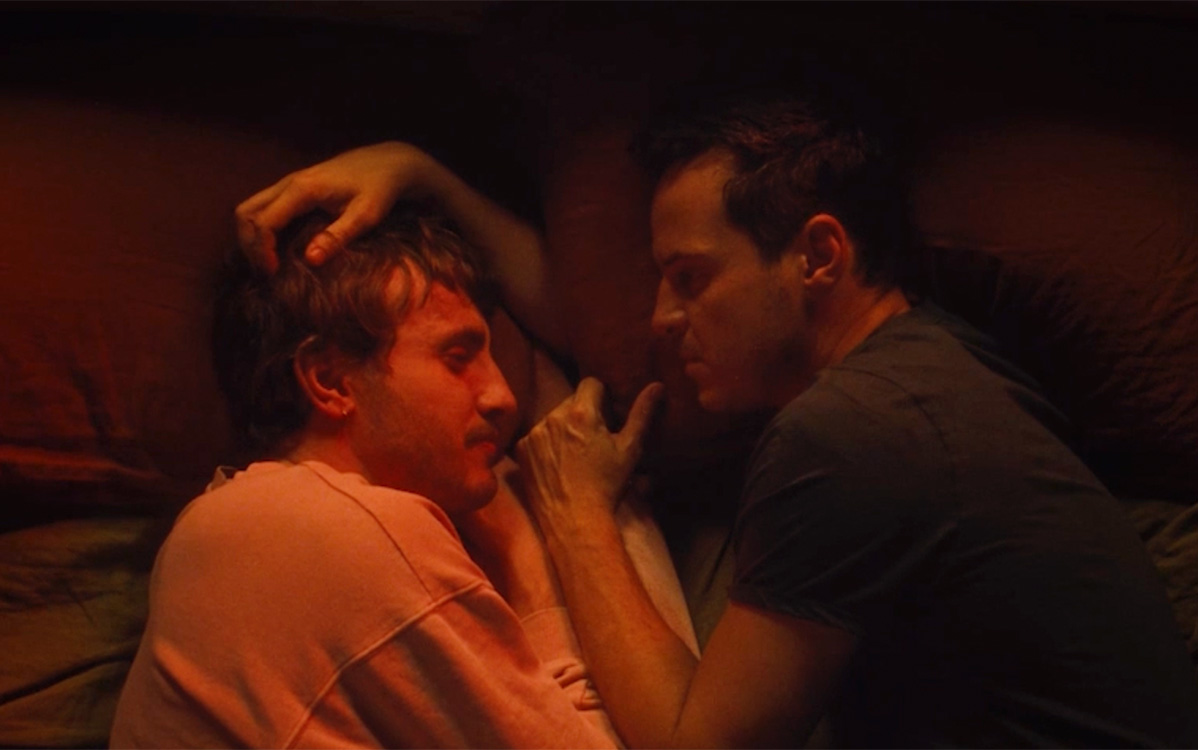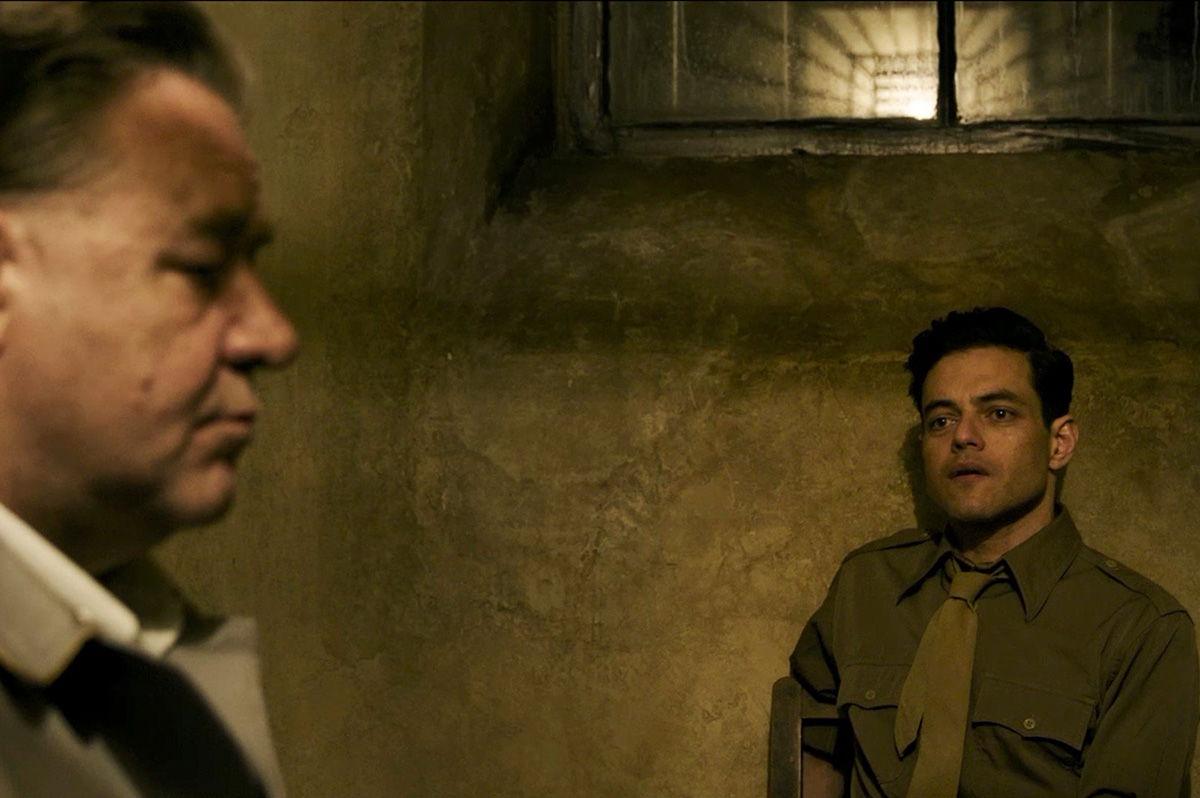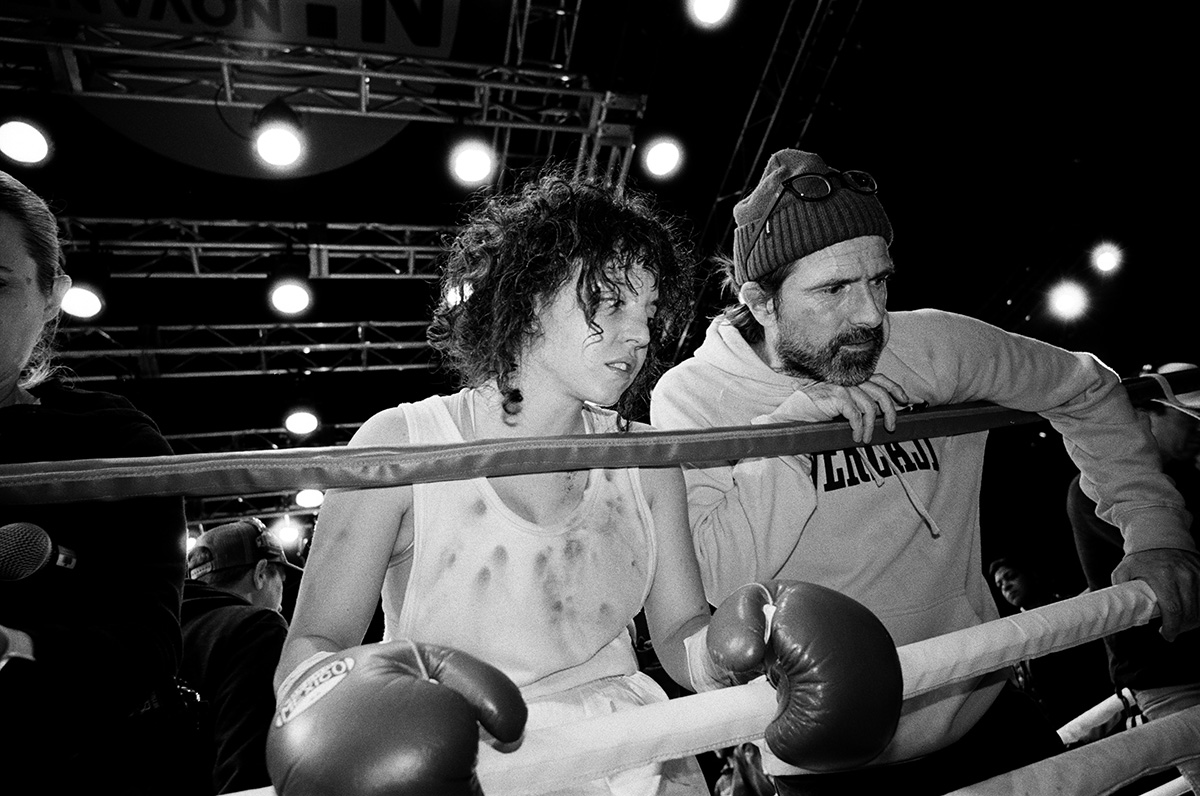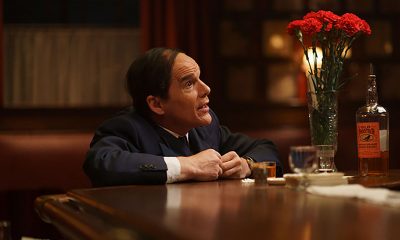Movies
The haunting – and haunted – queer love of ‘Strangers’
Haigh’s vision makes this one of the best films of the year

If you’ve read any “Best Of Queer Cinema” article written since 2011, you’re almost certainly familiar with Andrew Haigh’s “Weekend,” even if you’ve never seen it. A sexy but poignant tale of two men who fall in love during a one-night stand, it’s regularly ranked at or near the top when critics update their lists of such things, and for good reason. It’s romantic without being sentimental, intelligent without being emotionally distant, and – most important of all – it “gets” contemporary gay love in a way that makes it a touchstone for a generation of queer viewers who came of age in the aftermath of the AIDS years.
That generation is now more than a decade older, and so is Haigh, whose reputation as a filmmaker has only been bolstered in the interim by critical acclaim for subsequent films and his creation of HBO’s “Looking,” the short-lived and controversial queer series that nevertheless found enough loyal fans to warrant a movie-length finale after cancellation. Now, with his latest big-screen effort, the British writer/director delivers another stylishly composed melancholy romance; but though it may be true to introspective form, it also reflects the inevitable shifting of perspective that comes with middle age, and while its meditations have much to do with the beginnings and endings of love, its focus expands beyond those finite moments to explore the things that linger and become eternal – or at least, feel to us as if they are.
If that description sounds to you a little like the basis for a ghost story, you’re not wrong. “All of Us Strangers” – releasing on Dec. 22 – centers on Adam (Andrew Scott), a lonely 40-something Londoner living in a new-but-nearly empty London block of high-rise flats, whose current project conjures painful memories of his parents. Traveling to his childhood home, he finds Mum and Dad (Claire Foy and Jaime Bell) still living there exactly as they were, despite their tragic death in a car crash 20 years earlier. Incredulous though he may be, he embraces the chance to reconnect with them, but a potential new beginning at home with one of his few neighbors – the handsome but palpably sad Harry (Paul Mescal) – might just be jeopardized by his growing obsession with dwelling in the literal past.
Based on the 1987 novel “Strangers” by Japanese author Taichi Yamada, Haigh’s film becomes a more personal expression by relocating the setting to London and reimagining the central character as a gay screenwriter. The scenes involving Adam’s interaction with his parents were even shot in his own childhood home. He also chose to downplay the story’s supernatural leanings in favor of a more esoteric approach to the narrative; these are not the gloomy, terrifying ghosts we meet in a horror story, but fully self-aware shadows of humanity whose only intention is to enact the redemptive completion they were prevented from achieving by their fate. Far from being mournful specters anchored in the sorrows of the past, their purpose seems dedicated to helping everyone involved, living or otherwise, move onward toward an always-uncertain future. Indeed, there is nothing about them that suggests a lack of life, if not for the inescapable fact of their deaths – something easy to dismiss as irrelevant given the vibrant reality of their presence.
However, there’s more mystery to the story than a pair of friendly ghosts. Like many of the year’s best films, the impact of “All of Us Strangers” depends greatly on a gradual revelation of details that would inevitably lose their power if they were known in advance, and though we wouldn’t exactly categorize it as a movie with a “twist” ending, it’s still better left to personal experience to discover the deeper secrets that lie beyond the premise we’ve already divulged. Suffice to say that, in crafting its not-so-spooky narrative, it places more emphasis on hope than on haunting – though it suggests that the two may be inextricably linked, despite all our assumptive instincts to the contrary – and leaves us feeling uplifted rather than unsettled. To put it another way, we can safely offer the clue that, in the blurred and nebulous reality inhabited by Haigh’s movie, the boundaries of time, space, and physical existence seem less important than the bonds that are formed by our souls, for want of a better word.
What that means, of course, is that viewers who prefer a more straightforward narrative, grounded in the commonly shared experience most of us agree to call reality, might well find Haigh’s metaphysical (and metaphoric) conceit a step too far to accept the ideas it proffers about the enduring impact of love – and the heartbreaks with which it goes hand in hand – on our lives. But even if one cannot quite get on board for the transcendent leaps the filmmaker asks us to make within his autobiograph-ish parable of grief and reconciliation, it’s hard not to be won over by the tenderness of the love story that serves as both counterpoint and bookend to the inevitable sorrow that permeates it. In depicting the burgeoning romance between Adam and Harry – two men, a generation apart, attracted to each other by a mutual recognition of sorrow and broken-ness – Haigh manages to capture an irresistibly pure sense of heartfelt connection. It’s the kind of love we all dream of finding, and thanks to the sweetness and empathy with which it is delivered, it may well convince even the most cynical audiences to believe in the possibility of its existence.
Much of that effect hinges on the gifts – and the chemistry – brought into the mix by leading men Scott and Mescal. The former, an Irish thespian best known in the U.S. for his recurring turn as arch-nemesis Moriarty opposite Benedict Cumberbatch’s BBC-imported “Sherlock” and his role as “Hot Priest” in Netflix’s “Fleabag,” delivers a breathtakingly raw performance as Adam. Without its being heavily expressed in his dialogue, he conveys the emotional quest on which his character’s life hinges without ambiguity or artifice and we feel it as if it were our own. As for Mescal, he brings a relatable yet still unfathomable vulnerability to the clearly damaged Harry; despite his heartthrob good looks, he makes us believe in the insecurity and despair that makes the equally damaged Adam feel like a lifeline for him, which helps the eroticism of their tasteful-but-unapologetic love scenes together seem as sacred as they are sexy. Bell and Foy provide deeply affecting performances, as well; and though their characters embody a different aspect of love, they deliver an equivalent emotional resonance that somehow ties everything together in an all-encompassing notion of love as a universal force that holds our hands both as we come into the world and as we go out of it.
It’s Haigh’s vision that is served by these awards-worthy performances, though, and the unexpectedly moving beauty of “All of Us Strangers” comes ultimately from him; that it comes so eloquently despite a narrative that leaves us with more mysteries than conclusions – yet still manages to vibrate with triumphant joy – makes it easily one of the best movies of the year.
Movies
In solid ‘Nuremberg,’ the Nazis are still the bad guys
A condemnation of fascist mentality that permits extremist ideologies to take power

In any year prior to this one, there would be nothing controversial about “Nuremberg.”
In fact, writer/director James Vanderbilt’s historical drama – based on a book by Jack El-Hai about the relationship between Nazi second-in-command Hermann Göring and the American psychiatrist who was tasked with studying him ahead of the 1945 international war crimes trial in the titular German city – would likely seem like a safely middle-of-the-road bet for a studio “prestige” project, a glossy and sharply emotional crowd-pleaser designed to attract awards while also reinforcing the kind of American values that almost everyone can reasonably agree upon.
This, however, is 2025. We no longer live in a culture where condemning an explicitly racist and inherently cruel authoritarian ideology feels like something we can all agree upon, and the tension that arises from that topsy-turvy realization (can we still call Nazis “bad?”) not only lends it an air of radical defiance, but gives it a sense of timely urgency – even though the true story it tells took place 80 years ago.
Constructed as an ensemble narrative, it intertwines the stories of multiple characters as it follows the behind-the-scenes efforts to bring the surviving leadership of Hitler’s fallen “Third Reich” to justice in the wake of World War II, including U.S. Supreme Court Justice Robert Jackson (Michael Shannon), who is assigned to spearhead the trials despite a lack of established precedent for enforcing international law. Its central focus, however, lands on Douglas Kelley (Rami Malek), a psychiatrist working with the Military Intelligence Corps who is assigned to study the former Nazi leadership – especially Göring (Russell Crowe), Hitler’s right-hand man and the top surviving officer of the defeated regime – and assess their competency to stand trial during the early stages of the Nuremberg hearings.
Aided by his translator, Sgt. Howie Triest (Leo Woodall), who also serves as his sounding board and companion, Kelley establishes a relationship with the highly intelligent and deeply arrogant Göring, hoping to gain insight into the Nazi mindset that might help prevent the atrocities perpetrated by him and his fellow defendants from ever happening again, yet entering into a treacherous game of psychological cat-and-mouse that threatens to compromise his position and potentially undermine the trial’s already-shaky chances for success.
For those who are already familiar with the history and outcome of the Nuremberg trials, there won’t be much in the way of suspense; most of us born in the generations after WWII, however, are probably not. They were a radical notion at the time, a daring effort to impose accountability at an international level upon world leaders who would violate human rights and commit atrocities for the sake of power, profit, and control. They were widely viewed with mistrust, seen by many as an opportunity for the surviving Nazi establishment to turn the fickle tides of world opinion by painting themselves as the victims of persecution. There was an undeniable desire for closure involved; the world wanted to put the tragedy – a multinational war that ended more human lives than any other conflict in history before it – in the rear-view mirror, and a rush to embrace a comforting fantasy of global unity that had already begun to disintegrate into a “cold war” that would last for decades. “Nuremberg” captures that tenuous sense of make-it-or-break-it uncertainty, giving us a portrait of the tribunal’s major players as flawed, overburdened, and far from united in their individual national agendas. These trials were an experiment in global justice, and they set the stage for a half-century’s worth of international cooperation, even if it was permeated by a deep sense of mistrust, all around.
Yet despite the political and personal undercurrents that run beneath its story, Vanderbilt’s movie holds tight to a higher imperative. Judge Jackson may have ambitions to become Chief Justice of SCOTUS, but his commitment to opposing authoritarian atrocity supersedes all other considerations; and while Kelley’s own ego may cloud his judgment in his dealings with Göring, his endgame of tripping up the Nazi Reichmarshall never wavers. In the end, “Nuremberg” remains unequivocal in its imperative – to fight against institutionalized racism, fetishized nationalism, and the amoral cruelty of a power-hungry autocrat.
Yes, it’s a “feel-good” movie for the times, a reinforcement of what now feels like an uncomfortably old-fashioned set of basic values in the face of a clear and present danger; mounted with all the high-dollar immersive feels that Hollywood can provide, it offers up a period piece that comments by mere implication on the tides of current-day history-in-the-making, and evokes an old spirit of American ideology as it wrangles with the complexities of politics, ethics, and justice that endure unabated today. At the same time, it reminds us that justice is shaped by power, and that it’s never a sure bet that it’s going to prevail.
While it’s every inch the well-produced, slick slice of Hollywood-style history, “Nuremberg” doesn’t deliver the kind of fully satisfying closure we might long for in our troubled times. For all its classic bravado and heartfelt humanism, it can’t deliver the comforting reassurances we desire because history itself does not provide them. Vanderbilt doesn’t try to rewrite the facts, or soften the blow of their lessons, and while his movie certainly feels conscious of the precarious times in which it arrives, it doesn’t try to give us the kind of wish-fulfillment ending we might long to see – which is ultimately which gives it a ring of bitter truth and reminds us that our world suffers from the evil of corrupt men even when they are defeated.
It’s a movie populated with outstanding performances. Crowe delivers his most impressive turn in years as the chillingly malevolent Göring, and Malek channels all his intensity into Kelley to create a powerfully relatable flawed hero for us to cheer; Shannon shines as the idealistic but practical Jackson, and Woodall provides a likable everyman solidity to counter Malek’s volatile intensity. It might feel early to talk about awards, but it will be no surprise if some of these names end up in the pool of this year’s contenders.
Is “Nuremberg” the anti-Nazi movie we need right now? It certainly seems to position itself as such, and it admittedly delivers an unequivocal condemnation of the kind of fascist, inhuman mentality that permits such extremist ideologies to take power. In the end, though, it leaves us with the awareness that any victory over such evil can only ever be a measured against the loss and tragedy that is left in its wake – and that the best victory of all is to stop it before it starts.
In 2025, that feels like small comfort – but it’s enough to make Vanderbilt’s slick historical drama a worthy slice of inspiration to propel us into the fight that faces us in 2026 and beyond.
Movies
Sydney Sweeney embodies lesbian boxer in new film ‘Christy’
Christy Martin’s life story an inspirational tale of survival

For legendary professional boxer Christy Martin, never in a million years did she expect to see the riveting story of her rapid rise to fame onscreen.
“When somebody first contacted me about turning my life into a movie, I thought they were joking,” Martin said at a recent Golden Globes press event for her movie, “Christy.”
“I was so afraid that my life would be as I call it, Hollywoodized.”
Martin was put at ease once she saw how committed co-screenwriters Mirrah Foulkes, and Australian filmmaker David Michôd were to the material, and how relentless actress Sydney Sweeney was to accurately portray her.
“Mirrah was very fair to me and treated me great on the paper … I feel like this is the most powerful group that could ever come together to tell my story,” she acknowledged.
In “Christy,” viewers see Martin’s combative spirit, in her ongoing quest to win each fight. Under her demanding coach turned manager-husband Jim Martin (played by Ben Foster), Christy is fearless in the boxing ring, yet increasingly troubled as she deals with the pressure of her mother, sexual identity issues, drugs, and a physically abusive marriage that almost ended in death.
“It’s crazy to see anybody, but especially Syd, become me,” she told the Los Angeles Blade. “It’s overwhelming! A little much for a coal miner’s daughter from a small town in southern West Virginia.”
For Sweeney, who is also a producer on the film, playing the courageous lesbian boxer has been a life-changing experience. “This is the most important character I have ever played. It’s the most important story I have ever told or will tell. It’s an immense honor to bring her to life.”
To become Martin, Sweeney worked hard to absorb as much information on her as possible.
“I had the real Christy, and then I had years and years of interviews and fight footage and her book and her documentary on Netflix that I was able to pull from. I like to build books for my characters, to create their entire life, from the day they’re born until the first time you meet them onscreen. So just kind of filling out the entire puzzle of Christy here.”
Sweeney said the many scenes where Martin’s mom couldn’t accept she was gay were immensely challenging to be a part of.
“That was probably one of the hardest scenes for me,” Sweeney noted. “I have very supportive parents, and I can’t imagine what it would be like to not have your mom or dad to turn to ask for help or guidance or just need support. So it was a very difficult scene to process.”
Equally challenging was the rigorous process Sweeney went through in order to become Martin in the movie.
“It was a huge physical transformation for me. I trained for two-and-a-half months before we even started filming, and I put on 35 pounds for the role, so it was a big transformation.”
As difficult as it was to deal with a film that dives into domestic violence, Sweeney was able to shake the character off when she was done at the end of each day.
“I have a rule for myself where I don’t allow any of my own thoughts or memories into a character. So when the moment they call ‘cut,’ I’m back to being Syd, and I leave it all in the scene, and that’s the story that I’m telling. Otherwise I’m just me; so I go home when I’m me.”
Martin hopes that audiences leave the theater with a sense of faith.
“I think we showed a path of how to get out of any situation that you might be in. And also, it’s very important to be true to you. Sometimes that takes a while — it took me a little while — but I’m happy to be true to me. And that’s what we want; the whole story is about being who you are.”
Sweeney would love viewers to walk away and demand to be “Christy Strong.”
“I hope that they want to be kind and compassionate to others around them, and be that helping hand. Christy’s story is singular, and yet her story of triumph, survival and continuation, supports those who are in experiences of domestic violence behind closed doors. She is one of the great champions.”
Sweeney loves that Martin is also a great advocate of new boxing talent. “That spark of life is something that I think at the end of the day, ‘Christy’ is about– it’s the spark to keep going and be who you are proudly.”
Movies
Superb direction, performances create a ‘Day’ to remember
A rich cinematic tapestry with deep observations about art, life, friendship

According to writer/director Ira Sachs, “Peter Hujar’s Day” is “a film about what it is to be an artist among artists in a city where no one was making any money.” At least, that’s what Sachs – an Indie filmmaker who has been exploring his identities as both a gay and Jewish man onscreen since his 1997 debut effort, “The Delta” – told IndieWire, with tongue no doubt firmly planted in cheek, in an interview last year.
Certainly, money is a concern in his latest effort – which re-enacts a 1974 interview between photographer Peter Hujar (Ben Whishaw) and writer Linda Rosenkrantz (Rebecca Hall), as part of an intended book documenting artists over a single 24-hour period in their lives – and is much on the mind of its titular character as he dutifully (and with meticulous detail) recounts the events of his previous day during the course of the movie. To say it is the whole point, though, is clearly an overstatement. Indeed, hearing discussions today of prices from 1974 – when the notion of paying more than $7 for Chinese takeout in New York City seemed outrageous – might almost be described as little more than comic relief.
Adapted from a real-life interview with Hujar, which Rosenkrantz published as a stand-alone piece in 2021 (her intended book had been abandoned) after a transcript was discovered in the late photographer’s archives, “Peter Hujar’s Day” inevitably delivers insights on its subject – a deeply influential figure in New York culture of the seventies and eighties, who would go on to document the scourge of AIDS until he died from it himself, in 1987. There’s no plot, really, except for the recalled narrative itself, which involves an early meeting with a French journalist (who is picking up Hujar’s images of model Lauren Hutton), an afternoon photo shoot with iconic queer “Beat Generation” poet/activist Allen Ginsburg, and an evening of mundane social interaction over the aforementioned Chinese food. Yet it’s through this formalized structure – the agreed-upon relation of a sequence of events, with the thoughts, observations, and reflections that come with them – that the true substance shines through.
In relaying his narrative, Hujar exhibits the kind of uncompromising – and slavishly precise – devotion to detail that also informed his work as a photographer; a mundane chronology of events reveals a universe of thought, perception, and philosophy of which most of us might be unaware while they were happening. Yet he and Rosenkrantz (at least in Sachs’ reconstruction of their conversation) are both artists who are keenly aware of such things; after all, it’s this glimpse of an “inner life,” of which we are rarely cognizant in the moment, that was/is their stock-in-trade. It’s the stuff we don’t think of while we’re living our lives: the associations, the judgments, the selective importance with which we assign each aspect of our experiences, that later become a window into our souls – if we take the opportunity to look through it. And while the revelations that come may occasionally paint them in a less-than-idealized light (especially Hujar, whose preoccupations with status, reputation, appearances, and yes, money, often emerge as he discusses the encounter with Ginsberg and his other interactions), they never feel like definitive interpretations of character; rather, they’re just fleeting moments among all the others, temporary reflections in the ever-ongoing evolution of a lifetime.
Needless to say, perhaps, “Peter Hujar’s Day” is not the kind of movie that will be a crowd-pleaser for everyone. Like Louis Malle’s equally acclaimed-and-notorious “My Dinner With Andre” from 1981, it’s essentially an action-free narrative comprised entirely of a conversation between two people; nothing really happens, per se, except for what we hear described in Hujar’s description of his day, and even that is more or less devoid of any real dramatic weight. But for those with the taste for such an intellectual exercise, it’s a rich and complex cinematic tapestry that rewards our patience with a trove of deep observations about art, life, and friendship – indeed, while its focus is ostensibly on Hujar’s “day,” the deep and intimate love between he and Rosenkrantz underscores everything that we see, arguably landing with a much deeper resonance than anything that is ever spoken out loud during the course of the film – and never permits our attention to flag for even a moment.
Shooting his movie in a deliberately self-referential style, Sachs weaves the cinematic process of recreating the interview into the recreation itself, bridging mediums and blurring lines of reality to create a filmed meditation that mirrors the inherent artifice of Rosenkrantz’s original concept, yet honors the material’s nearly slavish devotion to the mundane minutiae that makes up daily life, even for artists. This is especially true for both Hujar and Rosenkrantz, whose work hinges so directly to the experience of the moment – in photography, the entire end product is tied to the immediacy of a single, captured fragment of existence, and it is no less so for a writer attempting to create a portrait (of sorts) composed entirely of fleeting words and memories. Such intangibles can often feel remote or even superficial without further reflection, and the fact that Sachs is able to reveal a deeper world beyond that surface speaks volumes to his own abilities as an artist, which he deploys with a sure hand to turn a potentially stagnant 75 minutes of film into something hypnotic.
Of course, he could not accomplish that feat without his actors. Whishaw, who has proven his gifts and versatility in an array of film work including not only “art films” like this one but roles from the voice of Paddington Bear to “Q” in the Daniel Craig-led “James Bond” films, delivers a stunning performance, carrying at least 75% of the film’s dialogue with the same kind of casual, in-the-moment authenticity as one might expect at a dinner party with friends; and though Hall has less speaking to do, she makes up for it in sheer presence, lending a palpable sense of respect, love, and adoration to Rosenkrantz’s relationship with Hujar.
In fact, by the time the final credits role, it’s that relationship that arguably leaves the deepest impression on us; though these two people converse about the “hoi polloi” of New York, dropping legendary names and reminding us with every word of their importance in the interwoven cultural landscape – evoked with the casual air of everyday routine before it becomes cemented as history – of their era, it’s the tangible, intimate friendship they share that sticks with us, and ultimately feels more important than any of the rest of it. For all its trappings of artistic style, form, and retrospective cultural commentary, it’s this simple, deeply human element that seems to matter the most – and that’s why it all works, in the end. None of its insights or observations would land without that simple-but-crucial link to humanity.
Fortunately, its director and stars understand this perfectly, and that’s why “Peter Hujar’s Day” has an appeal that transcends its rarified portrait of time, place, and personality. It recognizes that it’s what can be read between the lines of our lives that matters, and that’s an insight that’s often lost in the whirlwind of our quotidian existence.
-

 Politics3 days ago
Politics3 days agoPro-trans candidates triumph despite millions in transphobic ads
-

 Opinions3 days ago
Opinions3 days agoDemocratic Socialism won’t win the whole country
-

 National3 days ago
National3 days agoUS bishops ban gender-affirming care at Catholic hospitals
-

 Maryland4 days ago
Maryland4 days agoSalisbury, Md. rainbow crosswalk removed on Veterans Day




















